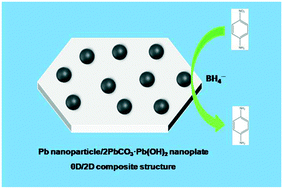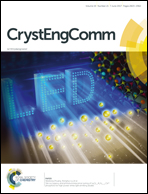In situ generated Pb nanoclusters on basic lead carbonate ultrathin nanoplates as an effective heterogeneous catalyst†
Abstract
Hexagonal ultrathin nanoplates of basic lead carbonates were synthesized in aqueous lead acetate solution under ambient conditions. The sizes of the nanoplates were found to reach several hundreds of nanometers to micrometers, whereas the plate thickness was only several nanometers, corresponding to 3, 4, or 5 stacking layers along the c-axis. These nanoplates exhibited effective catalytic properties for the hydrogenation of nitroarenes, such as nitrobenzene, 4-nitroaniline, and 4-nitrophenol, and other organic dyes, such as methylene blue and methyl orange in aqueous solutions in the presence of KBH4. Pb nanoclusters were generated in situ during the catalytic process and were well dispersed on the surface of the nanoplates, leading to the formation of a zero-dimensional/two-dimensional (0D/2D) heterostructure. It was also found that the heterostructure exhibited different catalytic behaviors for the hydrogenation of the compounds mentioned above due to the different molecular structures and different adsorption and desorption abilities of the reactants and products. Such a heterostructure can be also anticipated to be an effective photocatalyst due to its strong UV-light absorption, the ultrathin characteristics of the highly crystalline nanoplates and the transfer abilities of the Pb nanoparticles.



 Please wait while we load your content...
Please wait while we load your content...